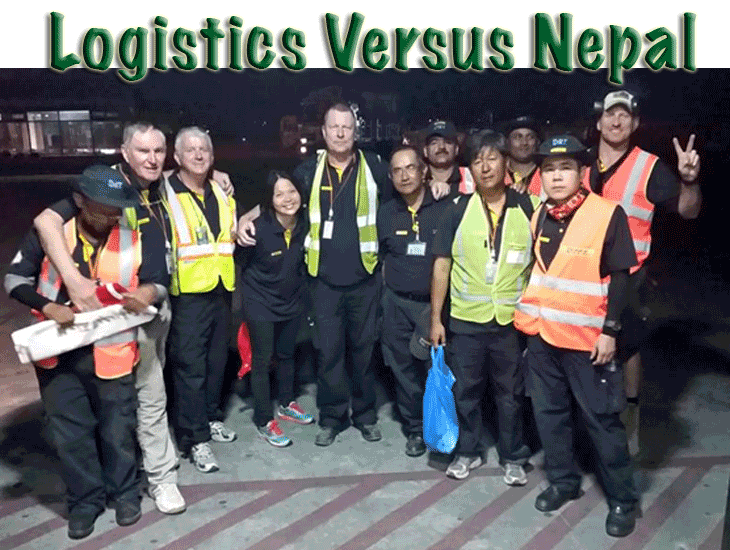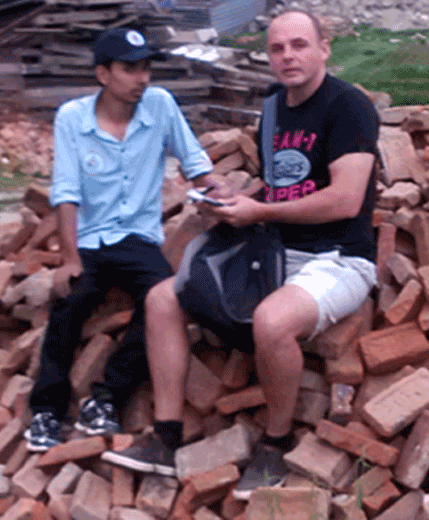 Kim
Melville (third from left) with the DHL Disaster Response Team in Nepal. Kim
Melville (third from left) with the DHL Disaster Response Team in Nepal.
On April 25 a 7.8 magnitude earthquake
devastated Nepal, but since then the Himalayan country has suffered more
than 90 aftershocks of over 4.0 magnitude, as well as a 7.3 quake on May
12, which was followed by a 6.3 quake an hour later.
Through much of this time Kim Melville,
senior director of Global Airside & Standards at DHL Express, has
helped corral aid arriving by freighter into Tribhuvan Kathmandu International
Airport (KTM) to a nearby U.N. staging area as quickly as possible. He
was part of DHL’s Disaster Response Team, which has been a notable
and singular industry presence in Nepal, where logistics expertise has
been in short supply.
Melville is something of a disaster specialist
- he was also involved in DHL’s effort to aid the Indian Ocean earthquake
and tsunami of 2004, Hurricane Katrina in 2005 and, in 2013, Typhoon Haiyan,
which left large swathes of the eastern Philippines almost post-apocalyptic.
“For Katrina we were deployed to Little
Rock Air Force Base where we sorted and distributed unsolicited aid,”
he said. “There was all sorts of incoming cargo including 40 tonnes
of rice from Thailand and U.N. kits, so we helped work out what to do
with it and dispatched it on behalf of the various organizations.
“In the Philippines, we worked at
Cebu Airport as part of the U.N.’s logistics cluster, handling inbound
freight that was then sent out to the Tacloban area.”
At KTM, DHL’s DRT has worked alongside
the U.S. Air Force, operating on the apron amid a steady flow of passengers
arriving on scheduled planes. Most of the cargo incoming by freighter
has then been taken to a nearby UN hub for onward distribution by truck,
although some has also been flown out direct via helicopter.
“With this operation at KTM, most
of the airlines coming offload at the side of aircraft, we then take control
of the freight and sort and arrange it for delivery by priority to the
World Food Programme’s compound, which is 1.5km away,” said
Melville. “From there it’s then distributed by WFP and NGOs.
“When we arrived the airport was clogged
with material—aircraft pallets and wooden pallets, all the aid etc.
So we did a cleanup initially. There was around 200-300 tons of freight
here.
“The biggest challenge is that passengers
have been coming in as normal, right through the cargo operations. There
is no separate cargo apron, which is unusual.”
After the second major quake on May 12 DHL
extended its stay until the end of May. As flows have normalized, the
operation has gradually become more efficient and the incoming humanitarian
effort has turned to road and sea, although Nepal’s unique topography
meant this happened later than is normal for most disaster response efforts.
“We normally stay two to three weeks,
but we were needed longer in Nepal because the airport was the main entry
point until, now, the focus has moved to trucks,” explained Melville.

SkyKing is working with a charity to raise USD
$50,000 for Nepal humanitarian efforts. This will be enough to feed
and provide shelter through the monsoon season for almost 600 families
in Sindhupalchowk, many of whom have been left homeless.
The devastation to the morale of Nepalese citizens
is difficult to quantify, but after having been struck not once, but
twice, it can only be assumed the citizenry is in the direst of straits.
If you would like to donate, please click here: |
“Overall we’re really pleased
with the DHL operation. We’re all volunteers and we want to do our
best alongside our local colleagues who have been really enthusiastic
and worked very hard even though many have damaged houses.”
When not responding to disasters on the
ground, Melville works for DHL’s “Get Airports Ready for Disaster”
(GARD) program, which was set up with the United Nations Development Programme
(UNDP) in 2009 and helped Nepal develop a disaster strategy, much of which
has been implemented in recent weeks.
“We thought rather than just going
out in an emergency, it was better to start training airports, and my
background is aircraft logistics and handling so that’s why I got
involved,” he said. “GARD aims to ensure airports are ready
to cope with a disaster, because once they have the initial surge of relief,
it can be very hard to manage without a plan in place.
“So GARD is about being proactive
rather than reactive. We run workshops with senior airport management
staff and government officials so they have an integrated national policy
plan in place in case the worst happens.
“We’ve now developed plans for
about 20 airports worldwide.
“I think what has happened here in
Nepal demonstrates how and why it’s better to plan ahead.”
SkyKing |





